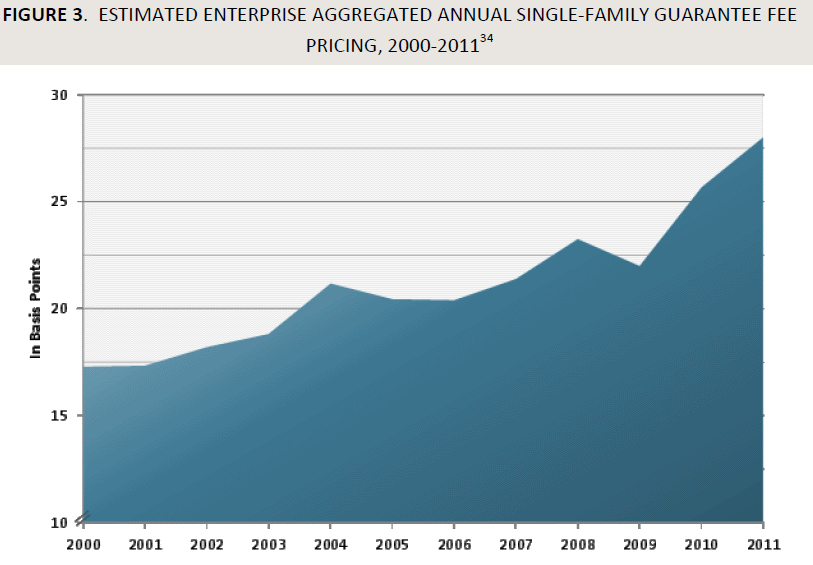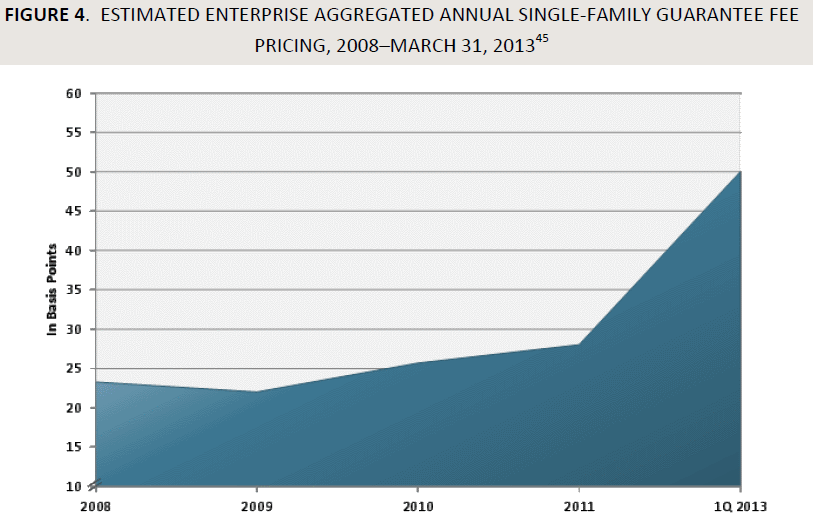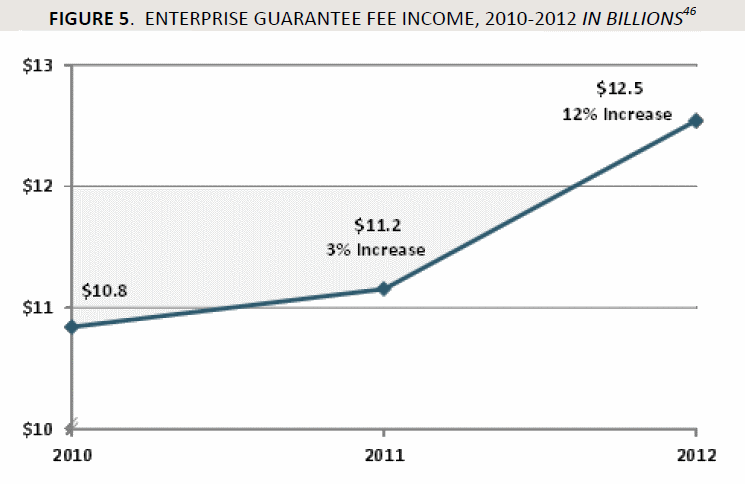The Office of Inspector General (OIG) of the Federal Housing Finance Agency (FHFA) has expressed some skepticism about FHFA's plans to gradually raise the guarantee fees (G-fees) of Freddie Mac and Fannie Mae in an attempt to lure private investors back into the housing finance system. In a report issued earlier this week, the OIG looks at the methods the two government sponsored enterprises (GSEs) used in the past to determine frees, the recent history of G-fee increases, and how FHFA will determine if their private sector goals are reached.
In 2012 the GSEs generated $12.5 billion in revenues from the single-family G-fees they charge to protect investors in their mortgage-backed securities (MBS) against potential credit losses. FHFA has argued that the federal financial support for the GSEs has allowed them to set their fees artificially low, increasing their risks and pricing competitors out of the market. FHFA has directed them to increase fees so as to encourage greater private sector investment in mortgage credit risk, lessen taxpayer risk, and reduce the dominant position the GSEs hold in housing finance.
At the same time the Federal Housing Administration (FHA) under the supervision of the Department of Housing and Urban Development (HUD) has raised its insurance premiums several times in recent years also in part to encourage private sector investment. However FHA has now announced it is discontinuing further premium increases. OIG conducted its evaluation to analyze FHFA's initiative and to assess its communications and interactions with FHA on their FHA's initiatives.
The GSEs use several methods in setting their guarantee fees. First, each employs a proprietary financial model to detrmine the credit risk by modeling the rate at which the underlying mortgages will default and the average losses on those that do (the loss severity rate.) If a GSE can reliably model the default and loss severity rates in a particular MBS set then it can estimate the credit risk and set an appropriate guarantee fee. The GSEs also employ their financial models to ensure that the fees are sufficient to cover their capital and administrative costs and certain other items.
The GSEs also rely upon business judgment in setting fees. They consider factors such as competitive market conditions, return on capital targets, and affordable housing goals. Freddie Mac told OIG investigators they also have traditionally considered the financial markets' view that Fannie Mae's MBS offer superior liquidity to their own and have attempted to provide financial incentives (i.e. lower fees) to compete in the market.
OIG said these methods aside, FHFA and others have argued that federal financial support for the GSEs has allowed them to set their guarantee fees lower than otherwise would have been the case because government support pre-conservatorship allowed the GSEs to issue debt at levels only slightly higher than those charged by the U.S. Treasury on securities with similar maturities. This ability to issue debt at favorable rates has continued under the conservatorships.
FHFA told OIG that this preferential support allows the GSEs to price their products and services, including MBS guarantee fees, at rates lower than would otherwise be feasible for a profit-motivated entity, provided them with an advantage over competitors that has allowed them to dominate the housing finance system and amplified their risks because the fees did not fully reflect the potential credit loses they would ultimately incur in fulfilling their commitments to MBS investors.
OIG found that during the housing boom of 2004-2007 the GSEs' guarantee fee rates were too low to mitigate the risks associated with their mortgage purchase and securitization practices and ultimately the losses on the GSEs' combined single family MBS guarantee business reached $218 billion. These losses exceeded their available capital of about $78 billion at the beginning of the conservatorship by a factor of about three to one. Starting in late 2007 the GSEs started to increase the fees to better protect themselves against credit losses and this trend has continued under the FHFA conservatorship.

FHFA and Enterprise officials have provided several reasons for the low guarantee fees set during the housing boom years. They have said that the financial models severely underestimated the risk from Alt-A and other mortgages and failed to predict the drastic decline in house prices when the housing bubble collapsed. They also concede that the guarantee fees were sometimes lower than called for by the financial models and were sometimes based in part upon business decisions to make the GSEs competitive with private lable mortgage-backed securities (PLMBS) issuers.
The GSEs nearly doubled their combined average G-fees to 50 basis points in 2012 due to a legislative mandate and a directive from FHFA. In an attempt to raise federal revenue, the Temporary Payroll Tax Cut Continuation Act of 2011 required FHFA to increase the gees by not less than 10 points, then FHFA required the GSEs to increase fees by 10 basis points as part of an overall plan to increase private sector investment and gradually end the GSEs' dominance in the housing finance system.
FHFA has stated that raising fees is consistent with efforts by Congress and the Administration to reform the housing finance system and many such proposals call for the elimination of the GSEs in their current form and their replacement with a new structure. FHFA's proposal to gradually downsize their market presence appears to be an attempt to provide a foundation for whatever strategy is ultimately adopted.
To this end the agency says it will continue to direct the GSEs to gradually increase the fees. However, OIG says, it is not clear how much higher fees will have to go in order to increase private sector investment nor has FHFA defined how it will measure it. This raises the level of uncertainty associated with the Agency's initiative.
As shown in Figure 4, the two mandated guarantee fee increases in 2012 caused the GSEs' combined guarantee fee to nearly double from 28 basis points in 2011 to 50 basis points by the first quarter of 2013.

Moreover, the Enterprises' guarantee fee income grew 12% in 2012 to $12.5 billion (see Figure 5).

Although recent guarantee fee increases have been substantial, available evidence suggests that they may not be sufficient to cause a material increase in private sector investment in mortgage credit risk. One GSE officials said the fees would, in general, need to rise considerably to affect such investment because they are not yet high enough to offset the GSEs' traditional cost advantages derived from federal support. A private company representative said the fees would need to increase by about one-third, 15 to 20 basis points, before there would be sufficient financial incentives for private investors.
FHFA officials recognize the fee increases must be gradual to avoid disruption to the markets and have said that future increases would likely be modest with considerable intervals between each to permit FHFA to assess market reaction and make adjustments as necessary.
OIG says FHFA has not developed any fixed definitions or methods to measure private sector investment. Such evidence might include a gradual return of a revamped Private Label MBS market, perhaps to historic levels (on average about 20 percent of all MBS issues in the 1990s). Or, an FHFA official said, financial institutions might be more willing to hold loans in their portfolios rather than sell them to the GSEs, thus retaining some credit risk. Alternatively, the fees might increase private sector participation "on the margin"; that is private institutions might be more willing to compete for the purchase of particular pools of mortgages but not conforming mortgages in general.
Officials from one GSE agreed with FHFA that private investment could vary and be difficult to measure. One reason is the private sector generally did not securitize the types of conforming mortgages that are the staple of the GSEs MBS guarantee business but rather those mortgages that did not meet GSE standards . This officials also said the increasing lender retention of mortgages would not necessarily indicate that rising G-fees were working. GSE-related credit costs such as guarantee fees are a relatively small factor in a lender's decision to sell a mortgage to a GSE or retain it on its own books.
While FHFA's could potentially transfer some of the credit risk to private sector investors, it also faces some trade-offs and challenges including reduced demand for mortgage credit and volume.
To some degree guarantee fees have always been built into the cost of conforming mortgages and it is likely that their inclusion in the overall price of mortgages has had only a minimal effect on the demand for housing finance. However as fees continue to rise they could become an important cost factor and any business must make a decision about which increased operating costs they pass on to consumers. "If guarantee fee increases are limited and housing and economic markets are strong, the the impact of guarantee fee increases upon borrowers will likely be mitigated."
Recent federal regulator initiatives designed to correct abusive and unsafe lending practices such at the qualified mortgage, retained risk, and ability-to-repay rules could involve trade-offs that present challenges to the FHFA initiative.
Changes could result in potential shifts in mortgage credit and risks between the conforming and government insured markets. FHA has raised its insurance premiums and tightened underwriting standards in order to strengthen its finances and encourage greater private sector investment in credit risk however, there is some potential that the FHFA and FHA initiatives could result in one of their markets becoming relatively more expensive or otherwise less attractive than the other. FHFA maintains that there is not much overlap between its market and that of FHA and both agencies have recently raised prices without significant shifts.
OIG recognizes the distinctions between the two but also notes that the current loan limits on FHA-insured mortgages is significantly higher in high cost areas than the conforming loan limit which could increase the relative attractiveness of FHA-backed mortgages and, although FHFA has directed the GSEs to raise its guarantee fees Ginnie Mae has not raised its MBS guarantee fee since 1972. Consequently there could be a growing cost disadvantage between Ginnie Mae and GSE guaranteed MBS. Further, HUD announced in April 2013 that FHA would no longer increase its mortgage insurance premiums so the potential exists for conforming mortgages and the GSEs' MBS to become relatively more expensive than FHA-backed mortgags and Ginnie Mae issued MBS.
Based on the above, OIG made the following findings and recommendations:
-
FHFA has yet to establish definitions or performance measurements for its initiative.
-
FHFA should seek to establish a more formalized arrangement with FHA to assess key issues involving their pricing initiatives. This would address critical issues such as the implementatioin of their pricing initiatives and the potential for shifts of mortgage business and risks between the two markets.
FHFA disagreed with the findings and recommendations of the report. In the first case the agency said it had earlier addressed those concerns and that, in lieu of a fixed quantitative target it intended to monitor the market closely. As regards its interactions with FHA, FHFA said the two were established as separate and independent entitites and that FHFA had always found that interactions between such organizations are better handled informally.







